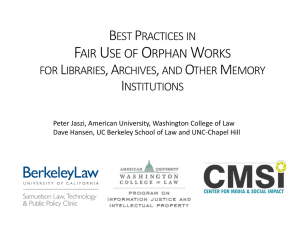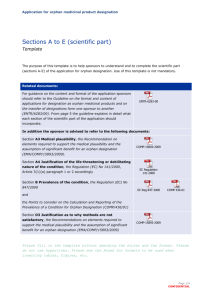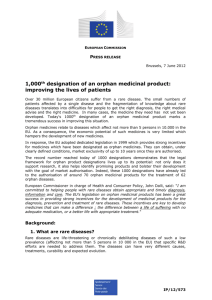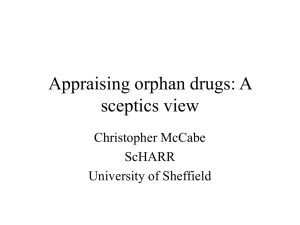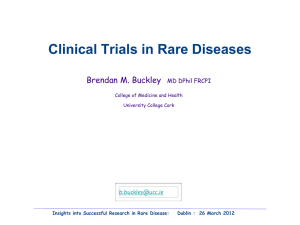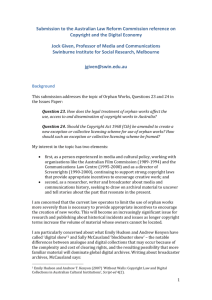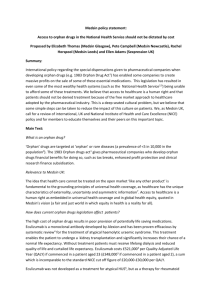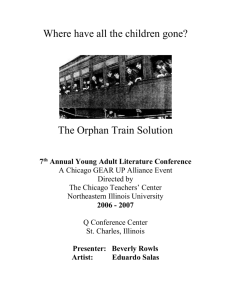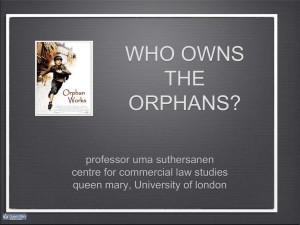September 2012 - Haffner Associates
advertisement
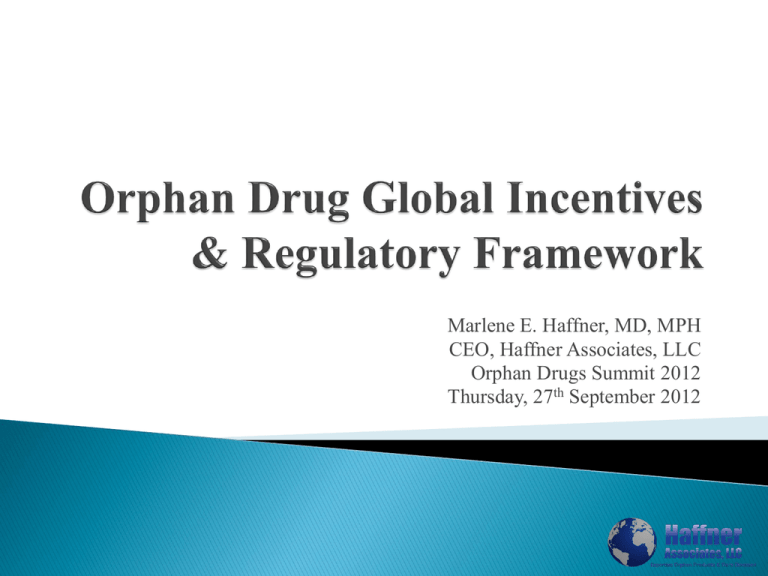
Marlene E. Haffner, MD, MPH CEO, Haffner Associates, LLC Orphan Drugs Summit 2012 Thursday, 27th September 2012 Slow pharma industry growth ◦ ◦ ◦ ◦ ◦ Patent expiration Generic Competition Drying Pipelines Biosimilars Regulatory Guidelines Lack of Investor Interest ◦ Reduction in ROI ◦ Lack of Success ◦ Economic Uncertainty Orphan Products Save the Day!? • • • • • • • • • Limited public awareness (invisible patient population) Scarcity of clinical expertise and reference centers – disease is poorly understood; no natural history Delay in diagnosis Small patient population – difficulty in recruiting to clinical trials Geographic dispersion Life threatening/chronic Heterogeneous conditions Difficult to stratify/stage – lack of natural history of disease Limited treatment availability Public Health Economies of Scale R&D Drivers Commercial Drivers Tax Credits Favorable reimbursement R&D Grants Fewer hurdles to approval Filing fees reduced or waived Longer/stronger exclusivity Shorter development timelines Lower marketing costs Greater Regulatory Success Faster Uptake Global Support Premium Pricing Source: Thomson Reuters Newport Premium, IMS Health US – the first 1982/3 Singapore – 1991 Japan – 1993 Australia – 1998 EU – 1999/2000 Taiwan, S. Korea, Hong Kong, S. Africa, Turkey, India… US EU Japan Designation Orphan Drug Act (1983) Rare disease = prevalence < 200,000 7 Year Market Exclusivity FDA Filing Fee Wavier Tax Credits for clinical trials Orphan Product Grants 400+ drugs approved; >2200 designated Use of accelerated approval/fast track Orphan Drug Regulation 141/2000 (1999) Rare disease = prevalence < 5 per 10,000 10 Year Market Exclusivity (6 + 4 years) Must be Serious or Life threatening disease Free Protocol Assistance; partial waiver filing fee Tax credits by member state Grants via 8th Framework COMP designates – 38 members ◦ chair, 1 from each MS, 3 patient organization members, 3 from CHMP, 1 each Norway, Lichtenstein, Iceland, 1 from EC 864 designated; 68 approved orphan drugs Orphan Drug Regulation ◦ Pharmaceutical Affairs Law Amendment (1993) Rare disease = prevalence < 50,000 (Population 120 million) 10 Year exclusivity Various Tax Incentives 50% reimbursement of development cost Designation must be for incurable disease with no alternative treatment Marketing authorization via fast track Source:MHLW Orphan Product Designation System Nation Programs Challenges India Indian Drugs Manufactures Association(2001) requested the government to institute the Orphan Drug Act. Enforcing Patent Laws and Market exclusivity Taiwan Rare Disease and Orphan Drug Act (2009) 159 classified rare diseases 77 approved orphan products Regulation Efficiency Safety Measures Local drug development South Korea Designation = Prevalence < 20,000 and diseases with no treatment in Korea 130 Orphan products approved Regulation through KFDA Usage limitations Hong Kong New Chemical Entity Registration Process Process Time Singapore Singapore’s Medicine Act -Inactive Definition is unclear; there is mentioning yet no details South Africa South African Foundation for Rare Disorders No strength, compliance, funding Australia Designation = Prevalence < 2,000 Focused on particular populations Not defined in law Source: Sharma, Abraham, Manas, & Dushyant. "Orphan Drug: Development Trends and Strategies." Improving – orphan diseases do not know territorial boundaries Approval Process – can have joint US/EU review and approval. Is cumbersome OOPD and COMP – regular meetings Designation application – US/EU – same format Not always aligned on definition of “what is the disease” Obvious differences in population requirements – surrogate for profitability EMA and MHLW/PMDA (Pharmaceuticals and Medical Device Agency) Relative contribution of Top-15 countries to the total scientific output for the 88 rare metabolic disorders† 1996-1998 2009-2011 O U T I N † De Vrueh, Remco. "China Has Joined the Fight against Rare Disorders." Glybera – first Gene therapy. Recommended for approval by CHMP. Awaiting EC approval Gevokizumab Multikinase inhibitor lenvatinib mesylate – thyroid CA – approved in Japan. US/EU studies ongoing Hemophilia B – AMT – also gene therapy. Not yet approved Approval requirements same for orphan products as for non orphan products. ◦ Product must be safe and effective for its intended use ◦ Not always easy to demonstrate ◦ Frequent post-marketing commitments Most frequent products are: Metabolic/endocrine; inborn errors; oncology; neurology ◦ ◦ ◦ 80% genetic 90 % Serious and/or life threatening (US); 100% serious/life threatening (EU) 50% children Difficulty in designing adequate clinical trials for such small populations – need excellent statisticians ◦ EU has white paper ◦ FDA will have guidance May have a preponderance of patients in a member state/nation ◦ Founder effect ◦ Cultural norms Protocol assistance/pre-IND meetings – used in US and EU and Japan. No charge FDA – Office of Orphan Products Reviews designation and Review Division grants product approval. Consult with each other. Office of Rare Diseases in CDER – works with orphan product policy in CDER EU – COMP reviews designation with concurrence by EC. Approval by CHMP with concurrence by EC Concordance between EU and US probably >90% ◦ Differences with disease definition ◦ And population numbers Designation consultation with MHLW Japan - frequent PDUFA 5/FDASIA – Section IX ◦ To implement more effective processes for expedited development and review of innovative new drugs to meet unmet needs § 901 (a) Expands Fast track – “serious and life threatening disease or condition” Accelerated approval - expands clinical benefit beyond usual surrogate endpoints to include epidemiological, pathophysiological, therapeutic, pharmacologic or other evidence developed using biomarkers Do the new provisions make a difference? Allows FDA to do what it has been doing already ◦ Helpful for Orphan Products ◦ Helpful for new FDA reviewers FDA may also withdraw products more easily Big PhRMA increasing involvement in Orphan Product Development Asian Markets - emerging Gene therapy – on the horizon Improvements in Diagnosis/Treatment/genetic markers Need for more Natural History Data Issues of Access/Cost - especially in individual Member States New platforms Chronic therapy – long lived products Over all - exciting, new technology, serving unmet needs for millions world wide! Marlene E. Haffner, MD, MPH President & CEO 11616 Danville Drive Rockville, Maryland 20852 mhaffner3@verizon.net 301 984 5729 - office 301 641 4268 - cell 301 984 2272 - FAX
